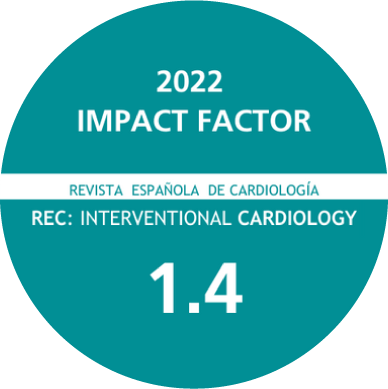Artículos originales \ Images in cardiology
“Edge to edge” transcatheter tricuspid repair for isolated posterior prolapse
aÁrea del Corazón, Hospital Universitario Central de Asturias, Oviedo, Asturias, Spain
bInstituto de Investigación Sanitaria del Principado de Asturias, Asturias, Spain
cDepartamento de Medicina, Universidad de Oviedo, Asturias, Spain
◊Both authors have contributed equally.
DOI: https://doi.org/10.24875/RECICE.M24000454
Disponible online: 10/04/2024
A new echocardiographic view for the TricValve system
Servicio de Cardiología, Complejo Universitario de León, León, Spain
DOI: https://doi.org/10.24875/RECICE.M24000445
Disponible online: 08/04/2024
Cyanosis after surgical closure of atrial septal defect
Servicio de Cardiología Pediátrica, Hospital Universitario La Paz, Madrid, Spain
DOI: https://doi.org/10.24875/RECICE.M23000432
Disponible online: 04/03/2024
Anterior AMI with an unusual angiographic image
aDepartamento de Cardiología, Hospital Universitario Clínico San Cecilio, Granada, Spain
bFundación para la Investigación Biosanitaria en Andalucía Oriental (FIBAO), Granada, Spain
cInstituto de Investigación Biosanitaria de Granada (Ibs Granada), Granada, Spain
DOI: https://doi.org/10.24875/RECICE.M23000422
Disponible online: 05/02/2024
Transcaval access for mechanical circulatory support in cardiogenic shock
aServicio de Cardiología, Hospital Universitari Vall d’Hebron, Vall d’Hebron Institut de Recerca (VHIR), Barcelona, Spain
bCentro de Investigación Biomédica en Red de Enfermedades Cardiovasculares (CIBERCV), Spain
DOI: https://doi.org/10.24875/RECICE.M23000431
Disponible online: 05/02/2024
Making matters worse with Impella
aUnidad de Cuidados Agudos Cardiovasculares, Hospital Clínico Universitario de Valladolid, Valladolid, Spain
bUnidad de Cardiología Intervencionista, Hospital Clínico Universitario de Valladolid, Valladolid, Spain
DOI: https://doi.org/10.24875/RECICE.M23000435
Disponible online: 05/02/2024
Ductus arteriosus presenting as systemic and pulmonary embolism
aFundación para la Investigación Biosanitaria en Andalucía Oriental (FIBAO), Hospital Universitario Clínico San Cecilio, Granada, Spain
bServicio de Cardiología, Hospital Universitario La Paz, Madrid, Spain
cServicio de Radiodiagnóstico, Hospital Universitario La Paz, Madrid, Spain
DOI: https://doi.org/10.24875/RECICE.M23000425
Disponible online: 30/01/2024
An unusual etiology of shock after ECMO decannulation
aUnidad de Cuidados Intensivos, Hospital Universitari Vall d’Hebron, Barcelona, Spain
bServicio de Cardiología, Hospital Universitario Vall d’Hebron, Barcelona, Spain
DOI: https://doi.org/10.24875/RECICE.M23000421
Disponible online: 14/12/2023
Severe postransplant tricuspid regurgitation: treatment with the PASCAL system
aServicio de Cardiología, Hospital Universitario Reina Sofía, Córdoba, Spain
bInstituto Maimónides de Investigación Biomédica de Córdoba (IMIBIC), Córdoba, Spain
DOI: https://doi.org/10.24875/RECICE.M23000413
Disponible online: 13/12/2023

